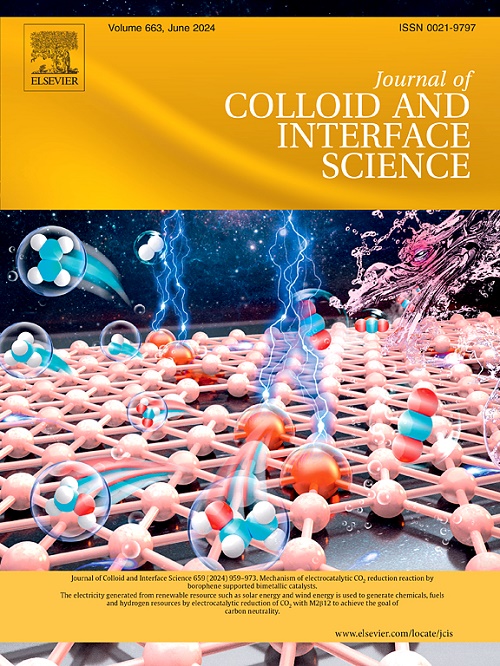SnO2晶体与多孔n掺杂碳纳米花之间的电子相互作用加速了CO2的电化学还原成甲酸。
IF 9.7
1区 化学
Q1 CHEMISTRY, PHYSICAL
引用次数: 0
摘要
电化学二氧化碳还原反应(CO2RR)生成甲酸或甲酸盐是实现碳中和的一种非常有效的方法。然而,多重质子耦合电子过程和表面中毒引起的催化剂的不稳定性极大地限制了CO2RR合成的整体效率。在这里,研究人员开发了一种简单的方法,将~ 2.60 nm的SnO2晶体锚定在多孔n掺杂碳纳米花(SnO2@N-GPC)上,以高效生产甲酸盐。在-1.2 V vs可逆氢电极(RHE)下,SnO2@N-GPC的最大法拉第效率(FE)可达96.3%,在-1.0 ~ -1.5 V vs RHE电位区可达80.0%以上,稳定运行10小时。实验结果和密度泛函理论(DFT)计算表明,SnO2与N-GPC之间的电子相互作用在界面处由SnO2向N-GPC转移,提高了SnO2@N-GPC的相稳定性,从而提高了其对CO2RR的稳定性。此外,电子相互作用增强了CO2在催化剂上的吸附,加快了关键中间体的形成速度,降低了生成甲酸酯的限速步骤的能垒。本研究为开发高活性、稳定的非贵金属催化剂为CO2转化为高价值化学品提供了有效的策略。本文章由计算机程序翻译,如有差异,请以英文原文为准。

Electronic interactions between SnO2 crystals and porous N-doped carbon nanoflowers accelerate electrochemical reduction of CO2 to formate
The electrochemical carbon dioxide reduction reaction (CO2RR) to formic acid or formate is a highly effective approach for achieving carbon neutrality. However, multiple proton-coupling-electronic processes and the instability of the catalysts caused by surface poisoning greatly limit the overall efficiency of CO2RR to formate. Here, a facile method was developed to anchor ∼2.60 nm SnO2 crystals onto porous N-doped carbon nanoflowers (SnO2@N-GPC) for high-efficiency formate production. The maximum Faraday efficiency (FE) of the SnO2@N-GPC reached 96.3 % at −1.2 V vs reversible hydrogen electrode (RHE) and was more than 80.0 % in the potential region from −1.0 to −1.5 V vs RHE with ten hours of operating stability. The experimental results and density functional theory (DFT) calculations demonstrated that the electronic interactions between SnO2 and N-GPC precipitated by electron transfer from SnO2 to N-GPC at the interface improved the phase stability of the SnO2@N-GPC, which improved its stability for the CO2RR. Furthermore, the electronic interactions enhanced the adsorption of CO2 on the catalyst, accelerating the rate of the formation of key intermediates, and reducing the energy barrier of the rate-limiting step for generating formate. This study provides an efficient strategy for developing highly active and stable non-precious metal catalysts for the conversion of CO2 to high-value chemicals.
求助全文
通过发布文献求助,成功后即可免费获取论文全文。
去求助
来源期刊
CiteScore
16.10
自引率
7.10%
发文量
2568
审稿时长
2 months
期刊介绍:
The Journal of Colloid and Interface Science publishes original research findings on the fundamental principles of colloid and interface science, as well as innovative applications in various fields. The criteria for publication include impact, quality, novelty, and originality.
Emphasis:
The journal emphasizes fundamental scientific innovation within the following categories:
A.Colloidal Materials and Nanomaterials
B.Soft Colloidal and Self-Assembly Systems
C.Adsorption, Catalysis, and Electrochemistry
D.Interfacial Processes, Capillarity, and Wetting
E.Biomaterials and Nanomedicine
F.Energy Conversion and Storage, and Environmental Technologies

 求助内容:
求助内容: 应助结果提醒方式:
应助结果提醒方式:


